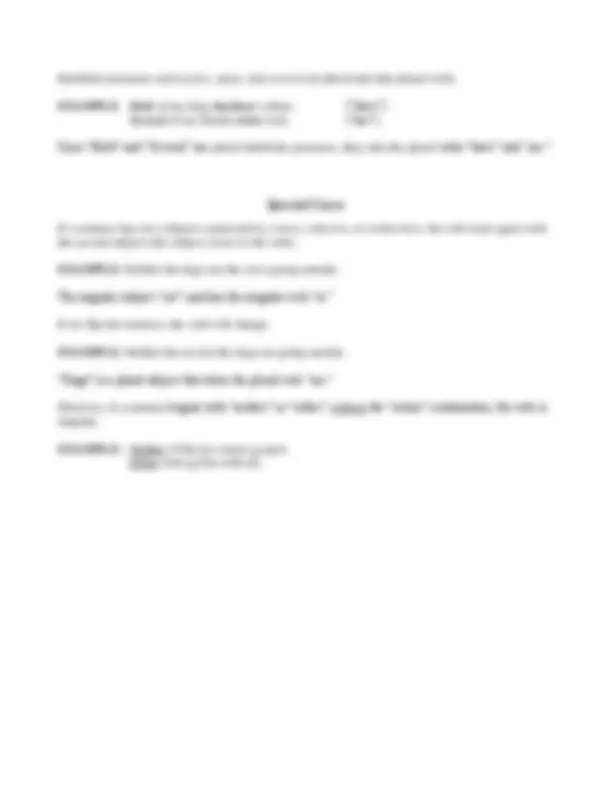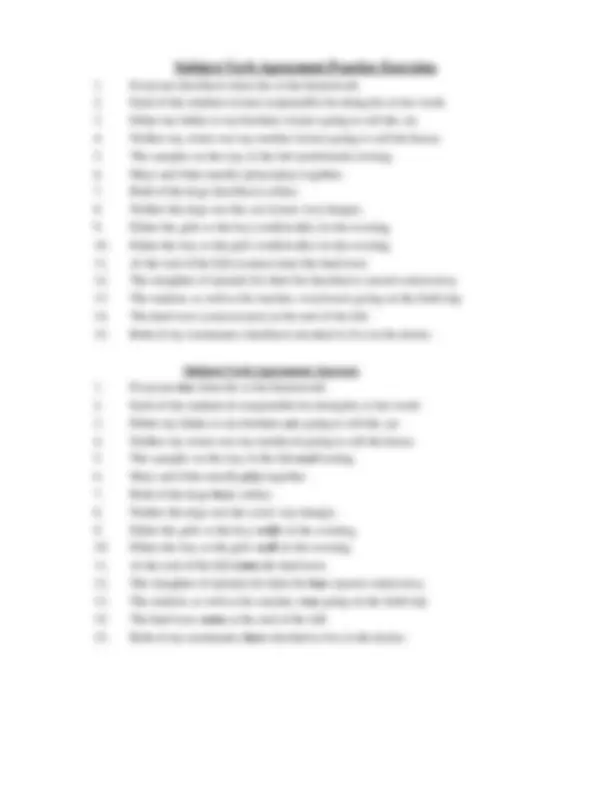




Study with the several resources on Docsity

Earn points by helping other students or get them with a premium plan


Prepare for your exams
Study with the several resources on Docsity

Earn points to download
Earn points by helping other students or get them with a premium plan
Community
Ask the community for help and clear up your study doubts
Discover the best universities in your country according to Docsity users
Free resources
Download our free guides on studying techniques, anxiety management strategies, and thesis advice from Docsity tutors
Subject-Verb Agreement Practice Exercises. 1. Everyone (has/have) done his or her homework. 2. Each of the students (is/are) responsible for doing his or ...
Typology: Lecture notes
1 / 4

This page cannot be seen from the preview
Don't miss anything!



A subject is a noun or pronoun. A verb is the action performed by the subject.
Verbs must agree with subjects in number and in person (1st/2nd/3rd).
EXAMPLE: The dog drinks his water every day.
“Dog” is a singular subject; “drinks” is a singular present tense verb. A common mistake in S-V Agreement is to assume that present tense verbs ending in “s” (ex: drinks, runs, dances) are plural. They are in fact singular. Be careful!
Singular Plural The girl dances. The girls dance. (No “s” on end of a plural verb!) The dog drinks. The dogs drink. The boy runs. The boys run. She plays. Mary and Laura play. She plays. They play.
Reminder: Singular present tense verbs end in “s” (Ex: The dog walks). Plural present tense verbs do not end in “s,” but plural subjects do (Ex: The dogs walk.).
Look at the sentence below.
EXAMPLE : The boxes of cake mix are on the shelf.
The verb is “are,” but what is the subject? Is it “boxes” or “cake mix”? In order to figure out the subject, we must eliminate the prepositional phrase which is often times in- between the subject and the verb.
A prepositional phrase is a two - to four - word phrase (sometimes more) that begins with a preposition ( above, among, at, below, beneath, between, in, of, over, to, under ). A verb must agree with its subject, not with the object of a prepositional phrase, which often comes between the subject and the verb.
EXAMPLE: The boxes of cake mix are on the shelf. Since “of” is a preposition, we ignore the prepositional phrase “of cake mix.” Therefore, “boxes” is the plural subject, which matches perfectly with the plural verb “are.”
Below are some samples of prepositional phrases:
Preposition Object of Prepositional Phrase above in the trees the lab among of the flowers the school at on the movies the bridge below over the trees the store beneath to the trees the table under
EXAMPLE: The teachers in the classroom is/are very experienced.
Since we know that “in” is a preposition, then it makes sense that “in the classroom” is a prepositional phrase. Cross out “in the classroom.” You are left with “The teachers... (is/are) very experienced.”
“Teachers” is a plural subject, so it must take the plural verb “are.”
However, what if we have an inverted sentence?
EXAMPLE: Under the tree is/are several flowers.
In this case, the verb must be plural (“are”) because the subject (“flowers”) is plural.
Simple pronouns and their numbers (singular/plural) are as follows:
Singular Plural 1st person I dance. We dance 2nd person You dance. You dance. 3rd person He/she/it dances They dance. Robert dances. Robert and Linda dance.
Singular indefinite pronouns take the singular verb.
EXAMPLE: Everyone in the class supports the teacher.
“Everyone” is a singular subject. “In the class” is the prepositional phrase. “Supports” is the singular present tense verb (notice the “s” on the end).
Other singular indefinite pronouns are anybody, anyone, anything, each, either, every, everybody, everyone, everything, neither, nobody, no one, somebody, someone, something.
EXAMPLE : Every man, woman, and child was/were given a book. (“was”) Each student is/are required to pass the final exam. (“is”)
Since “Every” and “Each” are both indefinite pronouns, they take singular verbs.
Subject-Verb Agreement Answers